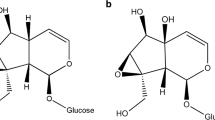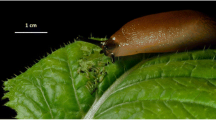Abstract
Specialist insect herbivores that sequester allelochemicals from their host plants may be unpalatable to potential predators. However, the host-plant species used may determine the degree of palatability. Spiders, including members of the family Lycosidae, are important predators of invertebrate prey. We fed buckeye caterpillars, Junonia coenia (Nymphalidae), reared on Plantago lanceolata (containing high levels of iridoid glycosides) or P. major (containing low levels of iridoid glycosides) to prairie wolf spiders, Lycosa carolinensis (Lycosidae), to determine whether the spiders found insects that sequester iridoid glycosides unpalatable. In a field experiment, spiders ate caterpillars reared on P. major significantly more often than caterpillars reared on P. lanceolata, although they attacked equal numbers of both types of prey. Spiders that bit caterpillars behind their heads or along the middle of their backs prevented caterpillars from implementing deterrent defensive strategies such as regurgitating or defecating. In a laboratory experiment, we presented spiders with P. lanceolata-reared and P. major-reared caterpillars simultaneously for eight consecutive trials. Spiders consumed P. major-reared buckeyes significantly more often than P. lanceolata-reared caterpillars. We found no evidence that the spiders learned to avoid the unpalatable prey.
Similar content being viewed by others
REFERENCES
Anderson, J. F. 1974. Responses to starvation in the spiders Lycosa lenta Hertz and Filistata hibernalis (Hertz). Ecology 55:576-585.
Bardwell, C. J., and Averill, A. L. 1996. Effectiveness of larval defenses against spider predation in cranberry ecosystems. Environ. Entomol. 25:1083-1091.
Belofsky, G., Bowers, M. D., Janzen, S., and Stermitz, F. R. 1989. Iridoid glycosides of Aureolaria flava (Scrophulariaceae) and their sequestration by Euphydryas phaeton (Nymphalidae) butterflies. Phytochemistry 28:1601-1604.
Bernays, E. A. 1988. Host specificity in phytophagous insects: Selection pressure from generalist predators. Entomol. Exp. Appl. 49:1153-1160.
Bernays, E. A., and Cornelius, M. L. 1989. Generalist caterpillar prey are more palatable than specialists for the generalist predator, Iridomyrmex humilis. Oecologia 79:427-430.
Bobbitt, J. M., and Segebarth, D. P. 1969. Iridoid glycosides and similar substances, pp. 1-145, in W. I. Taylor and A. R. Battersby (eds.). Cyclopentanoid Terpene Derivatives. Academic Press, New York.
Bowers, M. D. 1980. Unpalatability as a defense strategy of Euphydryas phaeton (Lepidoptera: Nymphalidae). Evolution 34:586-600.
Bowers, M. D. 1981. Unpalatability as a defense of western checkerspot butterflies (Euphydryas, Nymphalidae). Evolution 35:367-375.
Bowers, M. D. 1984. Iridoid glycosides and hostplant specificity in larvae of the buckeye butterfly, Junonia coenia (Nymphalidae). J. Chem. Ecol. 10:1567-1577.
Bowers, M. D. 1988. Chemistry and coevolution: iridoid glycosides, plants and herbivorous insects, pp. 133-165, in K. Spencer (ed.). Chemical Mediation of Coevolution. Academic Press, New York.
Bowers, M. D., and Collinge, S. K. 1992. Fate of ingested glycosides in different life stages of the buckeye, Junonia coenia (Lepidoptera: Nymphalidae). J. Chem. Ecol. 18:317-331.
Bowers, M. D., and Farley, S. 1990. The behaviour of gray jays, Perisoreus canadensis, towards palatable and unpalatable Lepidoptera. Anim. Behav. 39:699-705.
Bowers, M. D., and Stamp, N. E. 1992. Chemical variation within and between individuals of Plantago lanceolata (Plantaginaceae). J. Chem. Ecol. 18:985-995.
Bowers, M. D., and Stamp, N. E. 1993. Effects of plant age, genotype, and herbivory on Plantago performance and chemistry. Ecology 74:1778-1791.
Bowers, M. D., Boockvar, K., and Collinge, S. K. 1993. Iridoid glycosides of Chelone glabra and their sequestration by larvae of a sawfly. J. Chem. Ecol. 19:815-823.
Brower, L. P. 1984. Chemical defense in butterflies, pp. 109-134, in R. I. Vane-Wright and P. R. Ackery (eds.). The Biology of Butterflies: Symposium of the Royal Entomology Society number 11. Academic Press, London.
Camara, M. D. 1997. Predator responses to sequestered plant toxins in buckeyc caterpillars: Are tritrophic interactions locally variable. J. Chem. Ecol. 23:2093-2106.
Collinge, S. K. 1995. Spatial arrangement of patches and corridors in the landscape: Consequences for biological diversity and implications for landscape architecture. PhD dissertation. Harvard University, Cambridge, Massachusetts.
De la Fuente, M. A., Dyer, L. A., and Bowers, M. D. 1994/1995. The iridoid glycoside, catalpol, as a deterrent to the predator Camponotus floridanus (Formicidae). Chemoecology 5/6: 13-18.
Duff, R., Bacon, J., Mundie, C., Farmer, V., Russell, J., and Forrester, A. 1965. Catalpol and methylcatalpol: Naturally occurring glycosides in Plantago and Buddleia species. Biochem. J. 96:1-5.
Dyer, L. A. 1995. Tasty generalists and nasty specialists? Antipredator mechanisms in tropical lepidopteran larvae. Ecology 76:1483-1496.
Dyer, L. A., and Bowers, M. D. 1996. The importance of sequestered iridoid glycosides as a defense against an ant predator. J. Chem. Ecol. 22:1527-1539.
Dyer, L. A., and Floyd, T. 1993. Determinants of predation on phytophagous insects: The importance of diet breadth. Oecologia 96:575-582.
Edgar, W. D. 1969. Prey and predators of the wolf spider, Lycosa lugubris. J. Zool. London 159:405-411.
Farley, C., and Shear, W. A. 1973. Observations on the courtship behaviour of Lycosa carolinensis. Bull. Br. Arach. Soc. 2:153-158.
Foelix, R. F. 1996. Biology of Spiders, 2nd ed. Oxford University Press, New York.
Freed, A. N. 1984. Foraging behaviour in the jumping spider Phidippus audax: Bases for selectivity. J. Zool. London 203:49-61.
Gross, P. 1993. Insect behavioral and morphological defenses against parasitoids. Annu. Rev. Entomol. 38:251-273.
Guillebeau, L. P., and All, J. N. 1989. Geocoris spp. (Hemiptera: Lygaeidae) and the striped lynx spider (Araneae: Oxyopidae): Cross predation and prey preferences. J. Econ. Entomol. 82:1106-1110.
Gwynn, D. T. 1979. Nesting biology of the spider wasps (Hymenoptera: Pompilidae) which prey on burrowing wolf spiders (Araneae: Lycosidae, Geolycosa). J. Nat. Hist. 13:681-692.
Hallander, H. 1970. Prey, cannibalism, and microhabitat selection in the wolf spiders Pardosa chelata O. F. Miller and P. pullata Clerck. Oikos 21:337-340.
Holmberg, R. G., and Turnbull, A. L. 1982. Selective predation in an euryphagous invertebrate predator Pardosa vancouveri (Arachnida: Araneae). Can. Entomol. 114:243-257.
Jensen, S. R. 1991. Plant iridoids, their biosynthesis and distribution in angiosperms. Proc. Phytochem. Soc. Eur. 31:133-158.
Kuenzler, E. J. 1958. Niche relations of three species of Lycosid spiders. Ecology 39:494-500.
Krischik, V., and Denno, R. 1983. Individual, population, and geographic patterns in plant defense, pp. 463-512, in R. F. Denno and M. S. McClure (eds.). Variable Plants and Herbivores in Natural and Managed Systems. Academic Press, New York.
Malcolm, S. B. 1991. Cardenolide mediated interactions between plants and herbivores, pp. 251-295, in G. A. Rosenthal and M. R. Berenbaum (eds.). Herbivores: Their Interactions with Secondary Plant Metabolites Volume 1: The Chemical Participants. Academic Press, San Diego, California.
Moeur, J. E., and Eriksen, C. H. 1972. Metabolic responses to temperature of a desert spider, Lycosa (Pardosa) carolinensis (Lycosidae). Physiol. Zool. 45:290-301.
Montllor, C. B., Bernays, E. A., and Cornelius, M. L. 1991. Responses of two hymenopteran predators to surface chemistry of their prey: Significance for an alkaloid-sequestering caterpillar. J. Chem. Ecol. 17:391-399.
Nentwig, W. 1983. The prey of web-building spiders compared with feeding experiments (Araneae: Araneidae, Linyphiidae, Pholcidae, Agelenidae), Oecologia 56:132-139.
Nentwig, W. 1986a. A comparison of prey lengths among spiders. Oecologia 68:595-600.
Nentwig, W. 1986b. Non-webbing spiders: Prey specialists or generalists? Oecologia 69:571-576.
Nishida, R., and Fukami, H. 1989. Host plant iridoid-based chemical defense of an aphid, Acyrthosiphon nipponicus, against ladybird beetles. J. Chem. Ecol. 15:1837-1846.
Peterson, S., Johnson, N. D., and LeGuyader, J. L. 1987. Defensive regurgitation of allelochemicals derived from host cyanogensis by eastern tent caterpillars. Ecology 68:1268-1272.
Punzo, F. 1991. Field and laboratory observations on prey items taken by the wolf spider, Lycosa lenta Hentz (Araneae, Lycosidae). Bull. Br. Arach. Soc. 8:261-264.
Punzo, F., and Jellies, J. 1983. Comparative water relations of araneid and lycosid spiderlings (Arachnida). Comp. Biochem. Physiol. 74A:981-985.
Riechert, S. E. 1981. The consequence of being territorial: a spider case study. Am. Nat. 117:871-892.
Riechert, S. E. 1993. Spiders as representative sit-and-wait predators, pp. 313-328, in M. Crawley (ed.). Natural Enemies: The Population Biology of Predators, Parasites and Diseases. Blackwell Scientific Publications, Oxford.
Riechert, S. E., and Lockley, T. 1984. Spiders as biological control agents. Annu. Rev. Entomol. 29:299-330.
Rimpler, H. 1991. Sequestration of iridoids by insects. Proc. Phytochem. Soc. Eur. 31:314-330.
Ritland, D. B. 1991a. Revising a classic butterfly mimicry scenario. Evolution 45:918-934.
Ritland, D. B. 1991b. Unpalatability of viceroy butterflies (Limenitis archippus) and their purported mimicry models, Florida queens (Danaus gilippus). Oecologia 88:102-108.
Rovner, J. S. 1980. Morphological and ethological adaptations for prey capture in Wolf spiders (Arancae, Lycosidae). J. Arachnol. 8:201-215.
Rowell-Rahier, M., and Pasteels, J. M. 1991. Third trophic level influences of plant allelochemicals, pp. 243-277, in G. A. Rosenthal and M. R. Berenbaum (eds.). Herbivores: Their Interactions with Secondary Plant Metabolites Volume 1: The Chemical Participants. Academic Press, San Diego, California.
Scott, J. A. 1986. The Butterflies of North America. Stanford University Press, Stanford, California.
Shook, R. S. 1978. Ecology of the Wolf spider, Lycosa carolinensis Walckenaer (Araneae, Lycosidae) in a desert community. J. Arachnol. 6:53-64.
Stamp, N. E. 1992. Relative susceptibility to predation of two species of caterpillars on plantain. Oecologia 92:124-129.
Strohmeyer, H. H., Stamp, N. E., Jarzomski, C. M., and Bowers, M. D. 1998. Effects of prey species and prey diet on two invertebrate predators, stinkbugs and jumping spiders. Ecol. Entomol. 23:68-79.
Uetz, G. W., Bischoff, J., and Raver, J. 1992. Survivorship of Wolf spiders (Lycosidae) reared on different diets. J. Arachnol. 20:207-211.
Vasconcellos-Neto, J., and Lewisohn, T. M. 1984. Discrimination and release of unpalatable butterflies by Nephila clavipes, a neotropical orb-weaving spider. Ecol. Entomol. 9:337-344.
Author information
Authors and Affiliations
Rights and permissions
About this article
Cite this article
Theodoratus, D.H., Bowers, M.D. Effects of Sequestered Iridoid Glycosides on Prey Choice of the Prairie Wolf Spider, Lycosa carolinensis . J Chem Ecol 25, 283–295 (1999). https://doi.org/10.1023/A:1020894729188
Issue Date:
DOI: https://doi.org/10.1023/A:1020894729188




